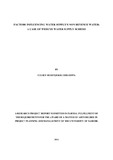Effects of Water Sources and Watering Frequency for Dairy Cattle on Water offered and Milk Production in Kiambu District
| dc.contributor.author | Muli, A N | |
| dc.contributor.author | Gachuiri, C K | |
| dc.contributor.author | Wahome, R G | |
| dc.contributor.author | Tanner, J | |
| dc.contributor.author | Kaitho, R | |
| dc.date.accessioned | 2013-02-20T10:08:03Z | |
| dc.date.issued | 2002 | |
| dc.identifier.citation | The Kenya Veterinarian Vol 23 (2002) | en |
| dc.identifier.uri | http://erepository.uonbi.ac.ke:8080/xmlui/handle/123456789/10432 | |
| dc.description.abstract | Data on water sources, mode of offer, watering frequency, amount of water offered, body weights and milk yield were collected from 21 randomly selected smallholder farms by means of farm visits and questionnaires fortnightly. Most Farms (67%) had water on-farm but 76% of them needed labour to deliver the water to the animals. Fifty two percent of the farms practised continuous watering. Water troughs (67%) were mostly used to water dairy cattle. Farms with on-Farm water offered dairy cows more (13411111 kg live wt) water compared to those collecting (76ml/kg live wt) or purchasing (8 Im1/kg live wt) water. Preliminary results on milk yield show that dairy cows with on-farm water produce less milk (6.4 IIday) compared with 8.0 Iiday and 9.0 1/day for those collecting or purchasing water respectively. Dairy cows using water troughs produced less milk (6.34 I/day) compared to 8.44 Iiday for those using bowls or buckets. | en |
| dc.language.iso | en | en |
| dc.subject | Dairy cattle | en |
| dc.subject | Milk yieds | en |
| dc.subject | Water offered | en |
| dc.subject | Watering frequency | en |
| dc.title | Effects of Water Sources and Watering Frequency for Dairy Cattle on Water offered and Milk Production in Kiambu District | en |
| dc.type | Article | en |
| local.publisher | Departmeni of Animal Production | en |
Files in this item
| Files | Size | Format | View |
|---|---|---|---|
|
There are no files associated with this item. |
|||



